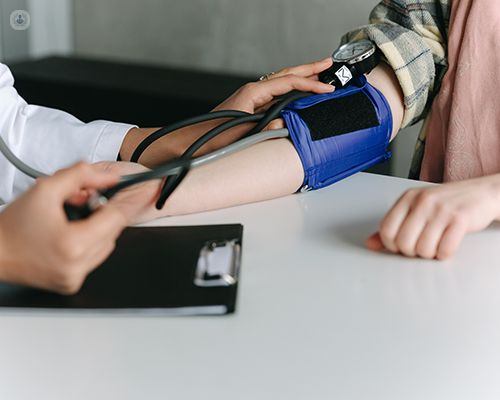Hypertension (high blood pressure) is a condition that can sometimes lead to severe health risks, including heart disease.
Dr Ashan Gunarathne, highly revered consultant interventional cardiologist, explains the causes of hypertension, the medications used to manage it, and when interventional procedures may become necessary.

What is hypertension?
Hypertension is a condition in which the force of the blood against the artery walls is consistently too high. Blood pressure is measured in millimetres of mercury (mmHg) and is recorded using two numbers: systolic and diastolic. A normal blood pressure reading is typically around 120/80 mmHg. Hypertension is diagnosed when blood pressure readings consistently exceed 140/90 mmHg.
Hypertension can be classified into two types:
Primary hypertension
Primary hypertension develops gradually over time and often lacks a single identifiable cause. However, it’s closely associated with genetics, ageing, obesity, stress, and lifestyle factors (a diet high in salt, lack of physical activity, excessive alcohol intake, smoking).
Secondary hypertension
Secondary hypertension is caused by an underlying medical condition or the use of specific medications. This includes conditions like kidney disease, hormonal disorders, thyroid dysfunction, and sleep apnoea. Common medications include decongestants and certain non-steroidal anti-inflammatory drugs (NSAIDs).
How can hypertension lead to heart disease?
Hypertension can cause significant damage to the cardiovascular system over time. When blood pressure remains consistently too high, the increased pressure in the arteries makes the heart work harder to pump blood, leading to heart-related issues such as:
- Heart attack: Hypertension can damage the arteries, accelerating the process of atherosclerosis where fatty deposits build up on the walls of arteries. Atherosclerosis can restrict blood flow, increasing the risk of a heart attack.
- Heart failure: The increased workload on the heart can lead to left ventricular hypertrophy, where the muscle of the left ventricle thickens. Left ventricular hypertrophy makes it harder for the heart to pump blood efficiently, which can eventually result in heart failure.
Furthermore, hypertension can damage the inner lining of arteries, making them more prone to forming blood clots that may cause stroke or other vascular complications.
What medications are used to manage hypertension?
Effective management of hypertension often begins with lifestyle changes, but medications are frequently required to achieve and maintain target blood pressure levels. These include:
- Diuretics: Diuretics help the kidneys remove excess sodium and water from the body, reducing the volume of blood and, in turn, lowering blood pressure.
- ACE inhibitors: ACE (angiotensin-converting enzyme) inhibitors relax blood vessels by blocking the production of angiotensin II, a hormone that narrows blood vessels. This then allows blood to flow more easily and lowers blood pressure.
- Beta blockers: Beta blockers slow the heart rate and decrease the force of contractions, reducing the heart’s workload and, in turn, lowering blood pressure.
Other medications, such as alpha-blockers, aldosterone antagonists and direct renin inhibitors, may be prescribed in specific cases. It’s essential to take your prescribed medications consistently and follow up with your cardiologist to ensure optimal blood pressure control.
When are interventional procedures required for hypertension?
In many cases, hypertension can be managed effectively through medication and lifestyle adjustments.
However, certain situations may necessitate interventional procedures – for example, when blood pressure remains uncontrolled despite medication, when there is damage to vital organs such as the heart, kidneys or eyes, or when there are hypertension-caused complications. Common interventional procedures include:
- Percutaneous coronary intervention (PCI): If hypertension has led to the formation of blockages in the coronary arteries, angioplasty may be required to open up narrowed arteries and restore blood flow to the heart.
- Aortic stent grafting: If hypertension leads to the formation of an aneurysm that is at risk of rupturing, stent grafting may be required to reinforce the damaged section of the aorta and prevent the aneurysm from rupturing.
Regular check-ups with your cardiologist are essential to monitor blood pressure and ensure that it remains within an adequate range.
To book an appointment with Dr Ashan Gunarathne, head on over to his Top Doctors profile today.